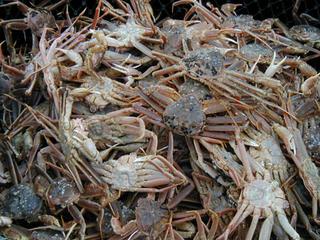Bering Sea Snow Crab Catch Limit Down 40 Percent

Wednesday, October 14 2015
Last week the Alaska Department of Fish and Game announced catch limits for the state’s crab fisheries. On Monday, a Fish and Game biologist explained how the agency determined those catch limits to a group of crabbers in Seattle. Nine local crabbers gathered at Unalaska’s City Hall to tune into the conference call and ask questions.
The biggest drop in total allowable catch – or the TAC – is for Bering Sea snow crab, also known as opilio. The total allowable catch this season for snow crab is just over 40 million pounds. That’s a forty percent drop from last season.
"I think a drop that large was a little bit of a surprise. I think everybody thought the management system for the opilio fishery was a little more on track than that. But it dropped, but hopefully it will rebound, hopefully it was just a weird year as far as the survey is considered," said Dutch Harbor crabber Casey McManus.
Managers use lots of different measures to figure out how big the catch can be. Fish and Game biologist Doug Pengilly says this year’s data from a trawl survey showed a decline in all measures of the snow crab stock. Measures like mature male biomass and the number of juvenile crabs. Pengilly says he and his colleagues started having concerns about the model they were using.
"This year the model really seemed to be diverging from all the other trends we saw," said Pengillly.
Pengilly explained the agency set last year’s catch based on a measure known as area swept estimates. That was the first time they did that since 2006. This year biologists decided not to rely on solely one measure.
"We set the TAC using a basically a combination of the model estimate and the area swept estimate, the estimate that comes right out of the survey data without having multi- or model put into it," said Pengilly.
Casey McManus said it's important that he and his fellow crabbers stay in close communication with biologists.
"We need to understand how they got to the numbers they did, and the science behind it, and if there is some things that are affecting the science, that we’re doing wrong, we can try to change that and we can learn from it so we can have a sustainable fishery in the future," said McManus.
The catch limit for Bering Sea red king crab is just under ten million pounds, roughly the same as last year. During the conference call, Pengilly also said the stocks of Pribilof blue and red king crabs are so low that those stocks will not be opened to commercial fishing in the foreseeable future.
The crab fishery opens at noon on Thursday.



